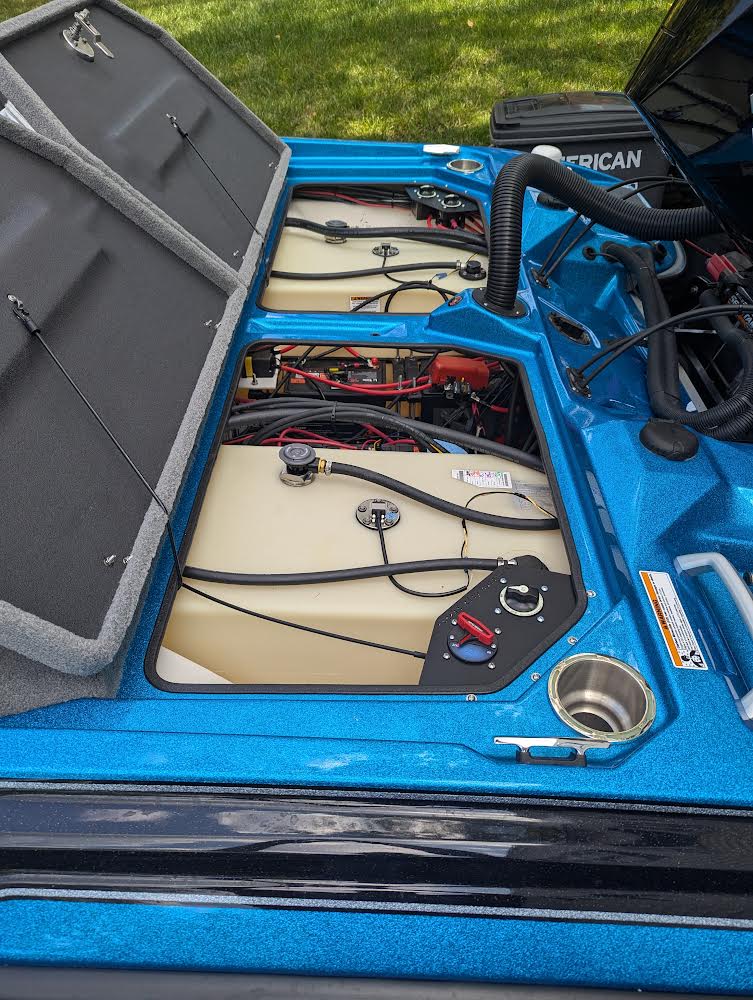
Avoiding EMI and Crosstalk: Why Your Trolling Motor Battery Switch and Wires Should Stay Clear of Marine Electronics
Share
Why Your Trolling Motor Battery Switch and Wires Should Stay Clear of Marine Electronics
As bass boat enthusiasts know, outfitting your rig with top-tier marine electronics like side scan, down scan, or forward-facing sonars can make all the difference in locating that trophy catch or securing those tournament wins. But what happens when your setup starts showing distorted images, interference lines, or unreliable readings? Sometimes, the culprit is electromagnetic interference (EMI) or crosstalk caused by improper placement of your trolling motor battery switch and wiring. In this post, we'll dive into why keeping these components separated is crucial for optimal performance, backed by insights from marine electronics experts. At Rocket City Outdoors, we specialize in custom bass boat accessories designed to help you avoid these issues—more on that later.
Understanding Electromagnetic Interference (EMI) in Bass Boats
Electromagnetic interference, or EMI, occurs when electrical noise from one device disrupts the signals of another. In a bass boat, the trolling motor is a prime source of EMI because its brushed electric motor generates significant electrical "noise" during operation, especially when spinning up or under load. (source) This noise radiates from the motor's lower unit and power wiring into the surrounding air and can be absorbed by nearby sensitive components, like the transducer cables connected to your marine electronics. (source)
Marine electronics rely on precise ultrasonic signals to map underwater structures and detect fish. When EMI infiltrates these systems, it can distort the sonar display, creating unwanted lines, dots, or static that make it nearly impossible to interpret readings accurately. (source) For instance, turning on the trolling motor might immediately trigger interference on your screen, which vanishes as soon as the motor is powered down. (source) This is particularly problematic for forward-facing sonars like LiveScope, where real-time clarity is essential.
The proximity factor is key: If your trolling motor battery switch or heavy-gauge wires are mounted too close to the transducer, its cable, or the electronics unit itself (often within a few inches to a foot), the EMI transmission intensifies. (source) Shared battery connections can exacerbate this, as noise from the trolling motor batteries can backfeed into the cranking battery powering your fish finder. (source)
The Role of Crosstalk in Boat Wiring Issues
Crosstalk is another common interference type, where signals from one wire or cable "bleed" into adjacent ones due to electromagnetic coupling. In boat wiring, this happens when high-power trolling motor cables (carrying 12V, 24V, or 36V DC) run parallel to or are bundled with the low-voltage signal wires from your marine electronics. (source) For example, if multiple fish finders are installed, their sonar cones might overlap, causing crosstalk that manifests as erratic depth readings or ghost images on deeper water scans. (source)
Trolling motor batteries and switches are hotspots for crosstalk because they handle pulsed currents that fluctuate with motor speed, inducing voltage spikes in nearby wires. Mounting the battery switch near your console-mounted sonar or running wires through the same conduit as transducer cables invites this problem, leading to unreliable performance during critical moments on the water.
Real-World Consequences for Anglers
Imagine you're on a tournament day, relying on your side scan sonar to spot submerged brush piles, only to see interference streaks obscuring the view. EMI and crosstalk don't just annoy—they can cost you bites, time, and even placements. Common symptoms include:
- Screen Noise: Vertical lines, dots, or "snow" appearing when the trolling motor engages. (source)
- False Readings: Inaccurate depth or fish detection due to signal distortion.
- Reduced Range: Interference limiting the effective range of down scan or forward-facing sonars.
In severe cases, unchecked interference can shorten the lifespan of your electronics by stressing internal components. Pros and recreational anglers alike report that separating power sources—wiring fish finders to the cranking battery instead of trolling motor batteries—often resolves these issues. (source)
Best Practices to Minimize EMI and Crosstalk
Preventing these problems starts with smart installation and maintenance. Here are actionable tips:
- Maintain Distance: Keep trolling motor battery switches and wires at least 12-18 inches away from marine electronics, transducers, and their cables. Route wiring separately whenever possible. (source)
- Use Dedicated Power: Connect your fish finder directly to the cranking battery with its own fused wire, avoiding any linkage to trolling motor batteries. (source) This provides "clean" power and reduces noise bleed.
- Shield and Suppress: Install ferrite beads on transducer cables near the electronics unit to filter out EMI. (source) Opt for shielded cables for all wiring runs, and ground your system properly to dissipate stray currents.
- Test and Isolate: Disconnect chargers or Perko switches temporarily to identify sources. (source) If interference persists, consider upgrading to a brushless trolling motor, which produces less EMI.
At Rocket City Outdoors, our USA-made battery disconnect switch mounting brackets are engineered precisely for this purpose. Designed for brands like Bass Cat, Skeeter, and Ranger, these durable, powder-coated aluminum brackets allow you to securely mount your switches in corner positions—far from sensitive marine electronics—while providing easy access for maintenance. By relocating your switch away from the console or bow-mounted sonars, you can significantly cut down on EMI and crosstalk risks, ensuring crystal-clear readings every time.
Conclusion: Protect Your Investment and Enhance Your Fishing Experience
EMI and crosstalk might seem like technical jargon, but they're real threats to your electronics performance. By keeping your trolling motor battery switch and wires isolated from marine electronics, you'll enjoy reliable sonar data, fewer frustrations, and more time focusing on the fish. If you're upgrading your setup, check out our collection of battery disconnect switch mounting brackets at Rocket City Outdoors—100% MADE IN THE USA custom solutions built by anglers, for anglers.
Tight lines!










